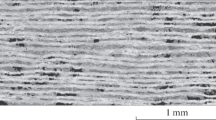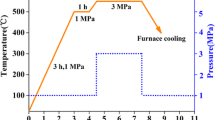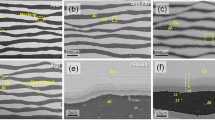The properties of laminated ceramic systems, especially those with low-strength bonds, are discussed. It is shown that residual stresses, which depend on the physical and mechanical characteristics (such as strength, thermal expansion coefficient, thickness, intensity of interfacial interaction) and structure of the main layers and interlayers, affect the fracture behavior of composites. Laminated materials with low sensitivity to defects and strength as high as that of the main layer were produced using a number of oxygen-free refractory compounds.








Similar content being viewed by others


References
O. N. Grigoriev, A. V. Koroteev, A. V. Klimenko, et al., “Structure and strength of ceramic multilayered composites in functional gradient materials and surface layers prepared by fine particle technology,” in: M.-I. Baraton (ed.), Functional Gradient Materials and Surface Layers Prepared by Fine Particles Technology, Kluwer Academic Press, Dordrecht (2001), pp. 265–272.
O. N. Grigoriev, A. V. Koroteyev, A. V. Klimenko, et al., “Production and properties of laminated SiC– MeB2 ceramic,” Ogneup. Tekhn. Keram., 41, No. 1/2, 29–42 (2000).
A. Kristofersson, E. Menessier, R. Lundberg, et al., “The properties of silicon carbide laminates,” in: K. Niihara (ed.), Proc. 6th Int. Symp. Ceramic Materials and Components for Engines (October 19–23, 1997, Arita, Japan), Keirin (1998), pp. 118–123.
A. G. Atkins, “Imparting strength and toughness to brittle composites,” Nature, 252, 116–118 (1974).
A. G. Atkins, “Intermittent bondings for high toughness of high strength composites,” J. Mat. Sci., 10, 819– 832 (1975).
J. P. Favre, “Improving the fracture energy of carbon fiber reinforced plastics by lamination promoters,” J. Mat. Sci., 12, 43–53 (1977).
B. Maruyama and D. B. Gundel, “Spatially varied interfaces,” Scripta Materilia, 35, No. 3, 391–395 (1996).
M.-Y. He and J. W. Hutchinson, “Crack deflection at an interface between dissimilar elastic materials,” Int. J. Sol. Struct., 25, 1053–1067 (1989).
K. S. Blanks, A. Kristofersson, E. Carlstrom, and W. J. Clegg, “Crack deflection in ceramic laminates using porous interlayers,” J. Europ. Ceram. Soc., 18, 1945–1951 (1998).
K. Kendall, “Transition between cohesive and interfacial failure in a laminate,” Proc. Roy. Soc., A344, 287–302 (1975).
R. W. Rice, “Microstructure dependence of mechanical behavior of ceramics,” in: R. K. MacCrone (ed.), Treatise on Materials Science and Technology, Vol. II: Properties and Microstructure, Academic Press, New York (1977).
O. V. Gorik, O. N. Grigor'ev, D. Yu. Ostrovoi, et al., “Experimental and theoretical studies on the nonlinear stress–strain state of a laminated ceramic composite,” Strength Mater., 33, No. 6. 526–534 (2001).
G. V. Samsonov, Nonmetallic Nitrides [in Russian], Metallurgiya, Moscow (1969).
G. G. Gnesin, Oxygen-Free Ceramic Materials [in Russian], Tekhnika, Kyiv (1987).
A. V. Drozdov, V. V. Kutnyak, and A. N. Negovskii, “Experimental equipment for evaluation of the strength characteristics of ceramics materials,” Strength Mater., 32, No. 5, 516–523 (1999).
G. A. Gogotsi and V. P. Zavada, “Certifying advanced ceramics on the basis of mechanical properties,” Strength Mater., 25, No. 1, 55–62 (1994).
T. Ya. Kosolapova, T. V. Andreeva, T. S. Bartnitskaya, et al., Nonmetallic Refractory Compounds [in Russian], Metallurgiya, Moscow (1985).
G. V. Samsonov and I. M. Vinnitskii, Refractory Compounds [in Russian], Metallurgiya, Moscow (1976).
A. R. Andrievskii and I. I. Spivak, Strength of Refractory Compounds and Materials Thereof [in Russian], Metallurgiya, Chelyabinsk (1983).
P. S. Kislyi, M. A. Kuzenkova, N. I. Bodnaruk, and B. L. Grabchuk, Boron Carbide [in Russian], Naukova Dumka, Kyiv (1988).
Author information
Authors and Affiliations
Corresponding author
Additional information
Translated from Poroshkovaya Metallurgiya, Vol. 50, No. 9–10 (481), pp. 74–84, 2011.
Rights and permissions
About this article
Cite this article
Grigorev, O.N., Shcherbina, O.D., Kirlas, V.N. et al. Production of laminated ceramic composites based on AlN and B4C and study of their properties. Powder Metall Met Ceram 50, 632–640 (2012). https://doi.org/10.1007/s11106-012-9369-6
Received:
Published:
Issue Date:
DOI: https://doi.org/10.1007/s11106-012-9369-6


